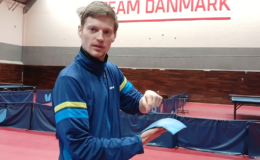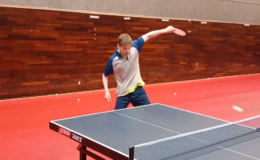By Larry Hodges, USATT Hall of Famer and National Coach
The hooking sidespin loop had its heyday in the early 1970s, with the rise of Hungary’s Istvan Jonyer, the 1975 World Men’s Singles Champion. Jonyer looped with a straight arm, and would often contact the ball on the far side, hooking the ball to the left (he’s a righty) with incredible sidespin. Often his racket tip would point straight down at contact, giving him essentially 100% sidespin. When players went to his forehand side, often he would loop around the net, with the ball barely rising above table level, and mostly rolling when it hit the far side – nearly unreturnable. Primarily because of Jonyer, the rules were changed, requiring the net to project six inches outwards. This makes around-the-net loops rare, though top players still do this shot sometimes from the very wide forehand.
However, while we may never see the sidespin dominance of a player like Jonyer again, most loops do have sidespin on them. According to former U.S. Men’s Coach Dan Seemiller, your typical forehand loop should be about 15% sidespin. This is the most natural loop – for most players, it would be tricky going for 100% topspin, as the racket naturally tips downward from the shoulder, and contact point is usually below the shoulder.
Yet some players like to go for extreme sidespins on some of their loops, especially on the forehand side. It’s a great way to mess up an opponent and set up your own shots. How and when do you do it? This is one of those shots where if you see a top player do it, it’s easy to copy.
The basic key for a hooking loop is contact the ball on the far side, by dropping the wrist so that the racket tip slightly down. It’s generally easier doing it from the wide forehand, though you can do it from anywhere on the court. When someone blocks to your wide forehand, and you have to stretch for the ball even a little bit, it’s best to get your racket outside the ball and hook it back with sidespin as well as topspin. If you do it to the opponent’s wide forehand, it jumps away from him, and the sidespin will both make his timing tricky and make it difficult for him to return it to your now open backhand side, and so you’ll usually get another forehand shot.
The opposite of a hooking sidespin loop is a slicing one (also called an inside-out loop), which is often done with the forehand from the backhand side to the opponent’s backhand side (so that it jumps away from the opponent), but it can be done from anywhere on the court. Instead of dropping the racket tip to hook the outside of the ball, you now raise your wrist so that the tip goes up, and contact the ball on your side of the ball so that it slices to the right (for a righty). This is usually a bit more difficult to learn, but once learned, it gives you a devastating one-two combo of hooking and slicing loops. Just as with a hooking loop, the slicing loop messes up the opponent’s timing, and usually forces a return toward your backhand.
Tired of throwing the usual topspins and backspins at your opponent? Have a little sidespin fun!



